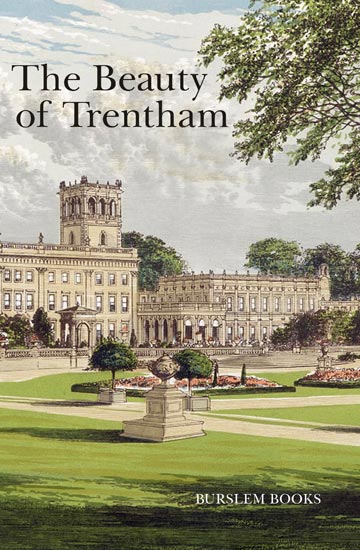A new article surveying the Peakland Spooklights…
“Strange lights in the sky hovering over rocky crags, dancing over wooded valleys, playing tag with each other, leading walkers astray.”
…in the Peak District and area.
A new article surveying the Peakland Spooklights…
“Strange lights in the sky hovering over rocky crags, dancing over wooded valleys, playing tag with each other, leading walkers astray.”
…in the Peak District and area.
Now available as an ebook for the Amazon Kindle ereader, the substantially expanded and revised second edition of my The Beauty of Trentham…

This special Kindle edition also contains additional historic texts describing the 19th century Trentham Park, Trentham Hall, and Trentham Gardens, not available in the paperback version.
As with all Kindle ebooks, a free sample of the first 10% of the book can be had on Amazon.
Painting Trentham Hall and Gardens, 1835-1935 runs until Sunday 8th July 2012 at the Newcastle-under-Lyme Museum and Art Gallery. This new exhibition of the art and illustration of Trentham Hall and Trentham Gardens includes some new works purchased recently at auction from Christies, by Henry Lark Pratt and the Minton factory. The rest seems to be drawn from the local museum archives. There’s a leaflet but no catalogue, so visit while you can. There are a few interesting items missing, such as the picture from 1872 which is seen below. Also missing are the major paintings by E. Adveno Brooke; Plot’s image of the first Trentham Hall in 1686 (although admittedly that’s before 1835); the watercolour map of the gardens and the hall elevation plan by Sir Charles Barry; the engravings of the Hall interiors in the 1880s; and the many photographic images of the Hall in ruins in the 1910s.
The exhibition’s information boards rather oddly give the distinct impression that Trentham was not open to the public, but it obviously was…

Above: Public fair at Trentham Gardens, 1872. Not included in the exhibition.
“The park and gardens are both open to the public; the latter on gala days, and the former at all times” — The History of the Tea-cup, 1878.
“A boon indeed to the densely-packed population that live in the Potteries such a park as that of Trentham must be, for the park is open to the public.” — Vanity Fair, 1882.
“All who have a shilling to spend have run away to spend it [at] a grand gathering of visitors at Trentham Park where all comers may freely enjoy themselves on the greensward. […] from eight in the morning until five in the afternoon, visitors poured in in a continuous stream; and at that hour the crowd in the park could not have numbered many less than forty thousand. Some of the young men engaged in cricket, prison bars, and other athletics games; but the majority preferred amusements in which the fair sex could participate; and many were the parties engaged heart and soul in the stirring polka, and other favorite dances. Picnic parties luxuriated beneath the shade of the noble trees skirting the park. Those who preferred “pairing off” wandered along the numerous glades opening out in different directions.” — report in Kidd’s Own Journal, 1853.
“North Staffordshire people have for so long enjoyed the privilege of walking in Trentham Park that it has come to be regarded as a public park” — North Staffordshire Journal of Field Studies, 1974.
“… on no green spot in England have more kissing rings been formed than in Trentham Park. If they could all have been marked, as the rings were marked where the fairies used to dance… ” — memories of the old potter Charles Shaw, who does not appear to be talking about making of the traditional Christmas Mistletoe ‘kissing ring’.
Interesting 2003 academic paper on the folklore of the mandrake plant, from Anthony John Carter of North Staffordshire Hospital. No other mention of Staffordshire in it, sadly. The paper’s free online.
“The persistence of older patterns of popular belief was much stronger than is commonly allowed [from the 1860s to the 1960s]. Reporting from a late vantage, Hoggart noted how his grandparents, moving into Leeds in the 1870s, brought with them and long retained the remedies, sayings and ‘superstitions’ of a rural life. Later still J. Seabrook [the sociologist Jeremy Seabrook] records the memories and beliefs brought by his country kin into the industrial settlements of the Midlands and long surviving there”
— Jason Marc Harris. Folklore and the Fantastic in Nineteenth-Century British Fiction. Ashgate, 2008. (quote is actually Footnote 47, which is from the following source: Joyce, Patrick. Visions of the People: Industrial England and the Question of Class 1848–1914. Cambridge University Press, 1991.)